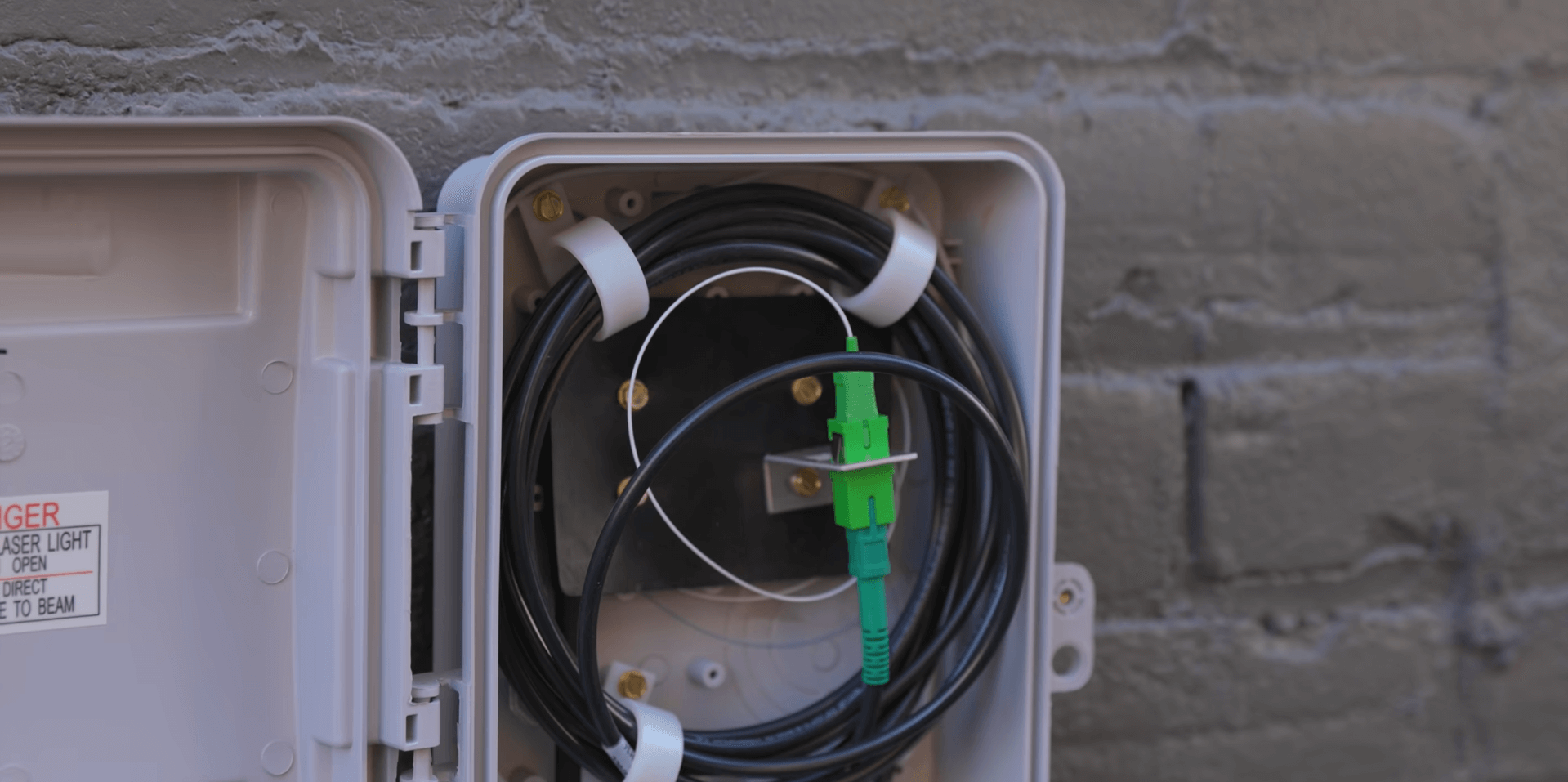Table of Contents
Even with advances in wireless technologies, running an Ethernet connection through a wall is occasionally necessary. Unfortunately, without the proper knowledge, it might not be easy. So, if you have been pondering how to run an Ethernet cable thru an exterior wall, you are in the right place!
Learning how to run an ethernet cable through the wall demands, you utilize several tools and drill holes in the wall. Likewise, you should avoid drilling into electrical, plumbing, HVAC, and other connections.
What Tools & Materials Do You Need To Run an Ethernet Cable Through a Wall?
Learning how to run an ethernet cable through walls without cutting drywall is difficult because cutting the drywall is necessary in most cases. Therefore, before you run an ethernet cable through a wall, you must obtain the appropriate equipment for the process.
The equipment you’ll need varies based on numerous factors, such as your walls, house, and coverage. Nonetheless, several tools are a must-have, including:
- Label Marker
- Drill
- Stud Finder
- Ethernet Crimping Tool
- Punch Down Tool
- Drywall Saw
- Paddle Bit
Besides these tools, you may require the following materials:
- Fish Tape
- Ethernet Wall Sockets
- Ethernet Switch
- Plastic Grommet
- Patch Panel
How to Easily Run an Ethernet Cable Through a Wall
Now that you have the right tools for the job, you can go ahead and run your ethernet cable through the wall using this guide:
1. Establish a Distribution Center

This is the initial step in running Ethernet cables through a wall.
To establish a distribution center:
- Switch off the room’s electricity to ensure your safety during drilling and wiring.
- Ensure you employ the correct studs for your wiring panel. With your stud finder, slip it along the walls to locate the appropriate studs.
- Drill holes between the studs and remove the ones that intersect. It ensures no barriers are behind the desired wall section.
- If there are no impediments behind the walls, continue to cut off the drywall until you reach the distribution center using the stud points.
- Mount a wire panel to the wallboard to organize the cords
2. Make Holes for the Ethernet Cable
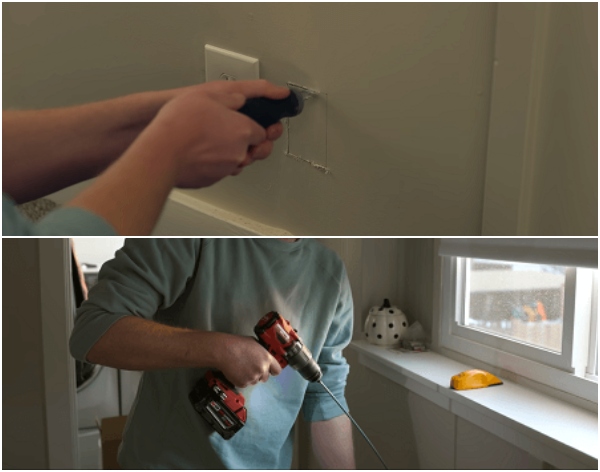
After building your distribution point, create cable holes according to the directions below:
- Based on your home, you might have to drill holes in your attic and flooring.
- Choose a position above the distribution center and remove the wood to form a link to the distribution center.
- From the attic, drill holes in the rooms you want your Ethernet connection. Upon creating the holes, drive the cables into the walls.
3. Identify Your Ethernet Cables
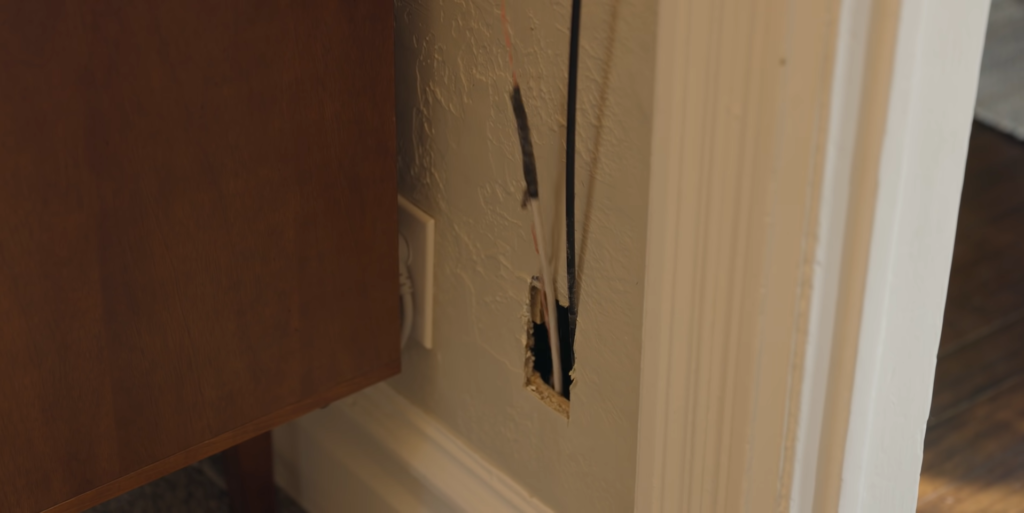
Make sure you know what cables you need, by identifying them.
- If you need an Ethernet connection in many rooms, you must mark the cables as per the rooms you intend to install.
- After identifying your cables, push them through the wall designated for every room.
4. Connect the Cables

Once you route all cables through the openings and walls, you may now crimp them. Utilize a punch-down tool to connect wires to ethernet wall sockets. Employ Velcro Straps or cable ties to secure the wires.
What Are the Dos and Don’ts When Running an Ethernet Cable Through Your Wall?
Knowing what to do and what not to do when running an ethernet cable through a wall is essential for your safety and the longevity of your wall and cables.
DOs
- Position the power cord at a 90-degree angle to avoid collisions.
- Use a variety of color-coded cables to maintain your cable layout orderly.
- Utilize an efficient cable system.
- Label the wires as per the desired placement position and termination method.
- Buy pre-connected wire to facilitate installation.
DON’Ts
- Avoid installing an excessive number of wires in one spot. It can overheat and lose quality.
- Avoid installing wires in hazardous locations, such as underneath the floor, above the water pipelines, or conduits.
- Termination of ethernet wires exposes them, which might cause harm to the terminal’s wires.
- Do not firmly bundle or tie your cables to avoid affecting their performance.
How To Run Ethernet Cable Thru an Exterior Wall Outside?
Here is how you run your Ethernet Cable through your exterior wall.
1. Place a Protective Ethernet Box
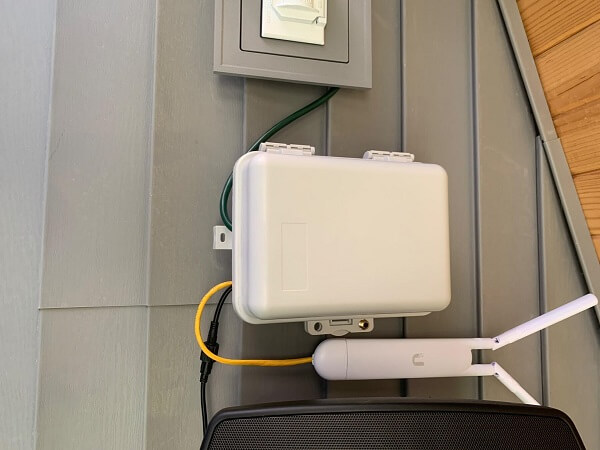
You should keep the connection between your Ethernet cable and the active Internet line out of direct sunlight and other potentially damaging environmental elements. Especially where it links to your ISP’s connection. If your residence lacks a waterproof box, you will need one.
2. Identify the Location
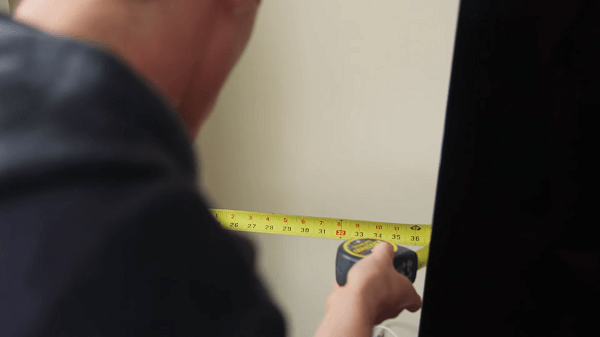
If your house lacks connection holes or specialized cables, you must drill into the walls. Find the precise area where you want to drill and highlight it with a pencil. However, extra caution is required to avoid damaging other electrical wires or pipes.
3. Make a Hole

When drilling the hole, determine where you want to run the wire. If you want to expand an ethernet connection into a room, you should drill from the inside rather than outside. This way, you can find the precise location the cable will enter your property.
To drill the hole, use a thick drill bit. Position the drill’s tip into the desired location for the hole. Balance the bit at an angle of 90 degrees towards the surface. To begin drilling, push the trigger gently. Then, gradually apply greater force to create a gorgeous, consistent hole.
4. Drive the Wire Into the Hole

Continually drive the cable into the hole until you reach the other hand. Don’t stretch the cable any further when inserting it directly into an interior location through an exterior wall.
Alternatively, you could run the Ethernet cable through the wall differently. Don’t immediately withdraw the drill from the hole upon drilling it. Pull the drill bit out of the drill. Then, attach one end of your cable to the drill and detach it.
5. Install a Wall Jack
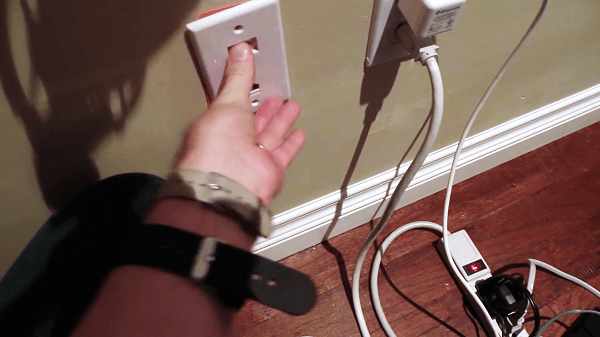
You may disregard this step if you have already drilled through an outside wall. However, fixing a wall jack will make connecting your gadgets to the ethernet connection easier.
Attach an RJ45 power connection to the external cable. You could then connect interior Ethernet cables to the jack. With this strategy, you’ll protect your home’s interior and exterior from the outside world.
How To Run Ethernet Cable Along a Wall
Do you struggle running your ethernet cable through the wall? If so, there is an alternative for you. You can run the cables along the wall with the help of cable concealers.
Some of the benefits of running the Ethernet cable along your wall include:
- You could easily eliminate the wires without further difficulties
- It decreases the dead space in your home’s connection
- It is not intrusive because you won’t have to mess with other wires in your home
- You could hard-wire high bandwidth gadgets
What Are the Different Types of Cable Concealers?

Cable concealers help conceal cables on the wall and protect them from harm. Typical examples of such concealers include baseboard and PVC concealers.
- PVC Concealers – PVC concealers are exceptionally effective in handling Ethernet cables. They also come in a variety of sizes and hues. Additionally, these concealers are customizable. Cable concealers are the most convenient and effective method for handling Ethernet wires. You might also use a latex-based painting to match the hue of your space.
- Baseboard Concealers – This concealer neatly covers your Ethernet cables. They resemble baseboard molding and offer an easy corner installation function. Due to their D-shaped design, they fit easily into wall corners. Furthermore, you do not have to use multiple nails to secure the concealer. Instead, you could paint it using latex-based paint to match the aesthetics of the space.
- Concealer Raceway – Based on the arrangement of your property, you might require multiple concealers. For instance, raceway concealers are great for wall corners. Nevertheless, if you want to run your wires vertically, you cannot use the PVC concealer alone since it would appear out of position once installed. Similar to other concealers, you could cut concealer raceways and paint them to your specifications. You could also all secure them using adhesives.
How Do I Run Ethernet Through a Wall With Insulation?

When installing an Ethernet cable in an insulated home, it is reasonable to feel intimidated by the process. Nevertheless, you could use various procedures with an insulated wall, whether foam, fiberglass, or cellulose, that will enable you to run wires through it. But all in all, ensure you do not create insulating gaps that would allow for air entry.
To begin, you should locate where you want to drill. Typically, irrespective of whether you are drilling from the upside or downside, you should aim for the corner of your wall cavity to avoid problems with the insulation.
After making the hole, here is how you should use insulation to snake wire through the wall.
- Method 1 – Follow the same route you created while drilling when fishing ethernet cable up or down. Utilize a fiberglass rod with a bullnose tip. If the ethernet cable you want to pass through is short, you could fasten it to the rod’s end. However, if you want to push through a longer cable or cable bundles, you could use a pull-cord and thread it through the bullnose to where you made a hole.
- Method 2 – Fasten a ball chain with a screw-on connection at the rod’s tip. Determine the length of chain you require, ensuring that the rod is always fed up or down a wall and within a few inches of where you cut a hole. After inserting the rod into the corner, use a magnetic retriever tool to capture the chain and drag it to the hole. When you have the retriever chained to the inside of the wall, you can pull it out.
- Method 3 – This technique requires a paddle magnet and a wire leader magnet. First, use a strong magnet to attach the wire leader to your fishing cable. Then, push the cable tied to the leader toward the wall with an opening. Push the paddle magnet against the wall and move until it links with the leader magnet, after which you can pull the magnet through the insulation using short, quick movements.
Frequently Asked Questions
Here are a few commonly asked questions regarding how to run an ethernet cable through the wall.
Can You Run Ethernet Cable Through PVC Pipe?
Yes! You might run a regular Ethernet cable through a PVC pipe or solid copper conduit with sealants at every connection point, but doing so is risky. It is because any dampness that enters the pipe might destroy the cable, requiring replacement.
How Far Can You Run Ethernet Cable Without Losing Speed?
It depends on what cable you use. The CAT5 standard, once utilized in every business, will support about a 100-meter range. Every 100 meters must have a tiny switch to span a longer distance, allowing larger distances to be achieved using current wires.
How Much Does It Cost To Run an Ethernet Cable Through a Wall?
There is no clear answer. The cost varies according to a range of factors. For example, how large is the home? How many rooms need wiring, and with how many outlets? Are the walls finished, or the wooden frame is still exposed? What type of cable is being installed?
Nonetheless, as a general rule of thumb, installing Ethernet wire in a home costs between $0.25 and $0.70 per foot of cable. There are various CAT cables, with CAT-5, CAT-6, and CAT-7 now being the most used. These varieties include shielded twisted pairs (STP) and unshielded twisted pairs (UTP).
Running an Ethernet Cable Through a Wall
Undoubtedly, wired connections have their advantages, but you must correctly wire your connections. While learning how to run an ethernet cable through the wall can be tricky, it is not impossible with the proper knowledge.
Hopefully, by reading this article, you now know how to run ethernet cables through walls without the assistance of a professional. Always ensure that you properly seal the holes after completion. You may contact a professional ISP provider if you find the work challenging.

